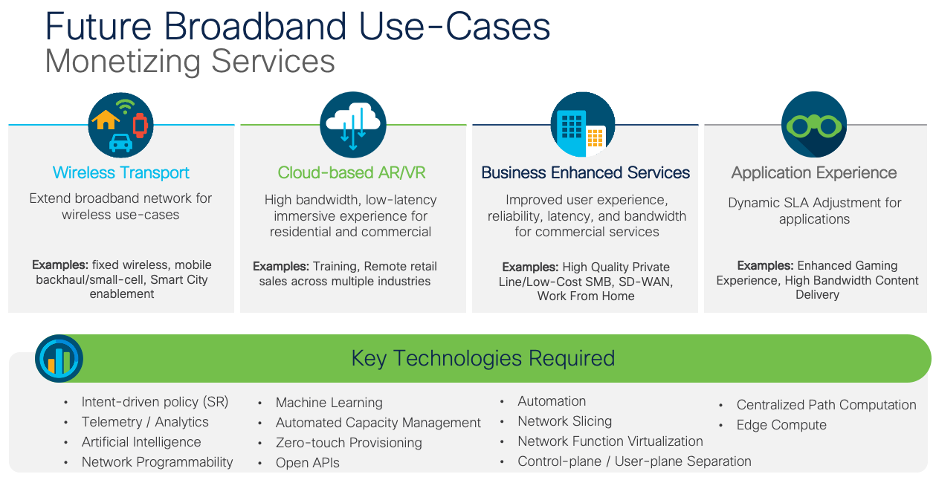- The best portable power stations for camping in 2025: Expert tested and reviewed
- "제조 업계, 스마트 기술 전환 중··· 95%가 AI 투자 예정" 로크웰 오토메이션
- What to Do If You Book a Hotel or Airbnb and It Turns Out to Be a Scam | McAfee Blog
- Cómo evitar la fuga de cerebros en TI
- Is ChatGPT Plus still worth $20 when the free version packs so many premium features?
Perspectives on the Future of Service Provider Networking: Software Defined Access Networks

By Marty Fierbaugh, Principal Architect | Co-authored by Emerson Moura
During the last two years, the pandemic has given us a new perspective on how digital transformation enables education, business, and consumer services. One positive takeaway from the pandemic is that the realization has set in for governments, enterprises, and consumers alike that reliable high-speed broadband access is a necessity. We’re seeing worldwide initiatives to expand connectivity to tens of millions of homes and millions of businesses for wireless services, satellite broadband, and most notably fiber network infrastructure. We’re truly at the dawn of a new era for access networks. As we explore the “Future of Service Provider Networking”, let’s look past the billions being invested in infrastructure and more closely examine what applications and their demands will look like with that “shiny new” infrastructure.
Today, broadband networks are architected to provide internet bandwidth and in many cases voice and video services. Service level differentiation of those services is typically provided using quality of service (QoS) and this model has served us well for just a few services. Also, the monetization of those services was much easier since the service providers offered them directly rather than the end-user consuming them over the top.
Imagine that future applications can embed the ability to signal to the network that they require specific treatment for minimum service levels or to ideally perform. That criteria could include many potential service objectives for minimum bandwidth, latency, or even what specific peering location would provide the best user experience. Real-time performance information, historical usage, and other demands combined with an understanding of the overall topology become a critical decision point. That decision can then be disseminated to the underlying network infrastructure where the policy would be enforced and continuously monitored to ensure those performance objectives are met.
This isn’t that far off considering that most content delivery applications already monitor their own performance and choose the most appropriate sources for the best user experience. What is missing from this view of the future is how a service provider enables and monetizes the enhanced user experience. That’s why we need to rethink how the network infrastructure is built. I don’t just mean parts of the network. The entire infrastructure needs to work together from access to the core, peering, aggregation, and subscriber management functions. As we look at the demands of future applications, it will be critical for the access network to be a programmable forwarding plane capable of supporting the application’s intent. This is where the software defined network (SDN) concept meets the access network. You may otherwise see it referred to as the software-defined access network (SDAN).
SDANs build the foundation for differentiated network or connectivity services. The capabilities of the network become the platform for which new and innovative business models can be built. Just as important is the ability to give applications and users of these services a way to request changes to connectivity “on-demand” and the service provider the ability to monetize the enhanced value the network is providing. We’re connecting “users and things” to “applications and services”. Those users and things are on the access network and those applications and services are increasingly delivered by either edge computing like content delivery networks (CDNs) or the public cloud. The figure below shows some examples of applications that would have vastly different service objectives than those of just “internet service” and these services can and will be delivered over broadband infrastructures.

As service providers face increased competition, they’re always looking for new ways to generate revenue and improve capital efficiency. Offering business-class services, wireless connectivity services, and even premium SLAs for subscribers are all enabled by the programmable network that SDAN enables.
Fiber-based broadband networks are being built at an unprecedented rate and the capital being invested is significant. SDANs are made possible by advances in forwarding silicon, network programmability, automation, and standardized programmatic interfaces. Those advances allow for a different approach to building access networks which would result in more efficient usage of that capital. As we look to the future, the build out of your broadband infrastructure will need to provide the new and differentiated SLAs that cannot be accomplished using legacy network architectures with vertically integrated software and proprietary interfaces. Building a software defined network and extending that to the access infrastructure allows you to support innovative new business models like enhanced gaming or business services.
This is one blog within a series of blogs titled Perspectives on the Future of Service Provider Networking and how emerging trends will impact enterprise and consumers. Catch the series of blogs coming from our group to learn more and get access to more content.
This year @CiscoLive in June we’ll be hosting an interactive panel, IBOSPG-2001 “Future Vision of SP Networking”. Our panel will share our point of view on the future of the service provider network. Please come join us and interact with the panel to learn more about our point of view.
Stay tuned for a podcast where Marty Fierbaugh and Emerson Moura will dive deeper on the topic of “Software Defined Access Networks”, going into more detail on the impact of automation, programmability, and data analytics on the access network to enhance subscriber experience and increase service provider revenues.
Share:

